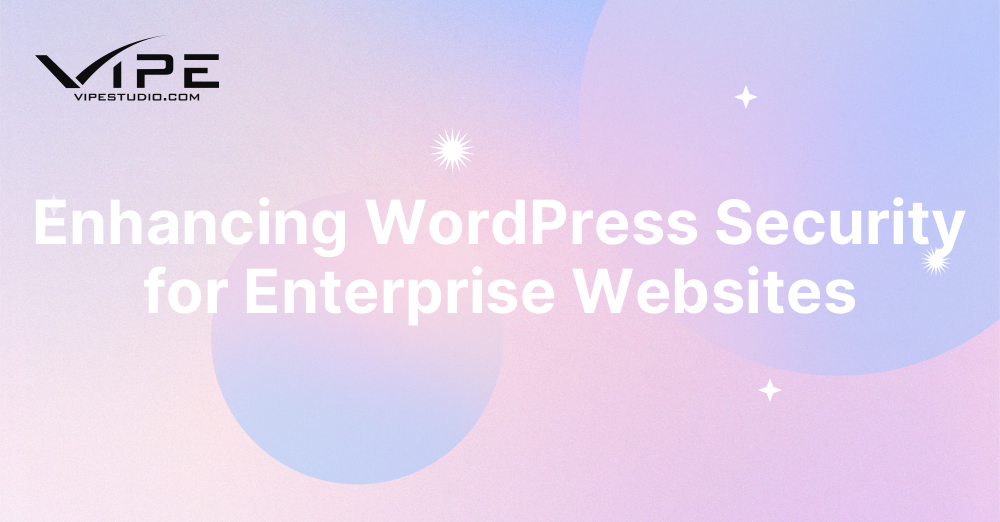06.04.2025
WordPress Development
Enhancing WordPress Security for Enterprise Websites
READING TIME: MIN
Table of Content
WordPress powers millions of websites worldwide, including those of large enterprises. While its flexibility and ease of use are key selling points, WordPress websites, especially at the enterprise level, are common targets for cyberattacks. Ensuring robust security practices is critical to protect sensitive data, maintain business continuity, and uphold your brand’s reputation. In this article, we will cover best practices to secure your enterprise WordPress site.
Why Security Is Vital for Enterprise WordPress Sites
Security is a primary concern for any website, but for enterprises, the stakes are much higher. A security breach can lead to the loss of customer data, intellectual property theft, website downtime, and a tarnished reputation. For large-scale WordPress sites handling sensitive customer information, securing data and maintaining privacy is not optional—it’s a necessity.
For WordPress enterprise sites, security is not just about keeping hackers at bay; it’s also about safeguarding the operational integrity and continuity of your business. Protecting your website can help ensure your clients’ trust and prevent costly downtime or recovery efforts.
Common Security Risks Facing WordPress Sites
WordPress sites are vulnerable to several types of cyberattacks, and enterprise-level sites are particularly attractive targets. Common threats include:
- Brute Force Attacks: Attackers attempt to gain access to admin accounts by systematically guessing passwords.
- SQL Injections: Malicious SQL queries are injected into the site to gain unauthorized access to the database.
- Cross-Site Scripting (XSS): Attackers inject malicious scripts into web pages that can steal data or infect users.
- Malware and Ransomware: Malicious software that compromises a website’s operation, potentially locking down data or causing irreversible damage.
- Theme and Plugin Vulnerabilities: Many WordPress themes and plugins can have outdated code, offering entry points for attackers.
Best Practices for Securing Your Enterprise WordPress Website
1. Keep WordPress Core, Themes, and Plugins Updated
WordPress developers continuously release updates to patch security vulnerabilities. This includes core WordPress updates, as well as updates to themes and plugins. An outdated WordPress site is an easy target for hackers looking to exploit known vulnerabilities.
Ensure that all software components are updated regularly:
- Automatic Updates: Enable automatic updates for minor WordPress core releases. For major updates, always test before implementing.
- Theme and Plugin Updates: Always update themes and plugins as soon as updates are available to close any security gaps.
2. Use Strong Passwords and Two-Factor Authentication
Weak passwords are one of the easiest ways for attackers to gain unauthorized access to a website. Using strong, unique passwords for all admin accounts is critical in safeguarding your site.
Consider these steps:
- Enforce Strong Passwords: Use a password manager to generate and store complex, unique passwords for each account.
- Two-Factor Authentication (2FA): Implement 2FA on your WordPress site to require both a password and a second form of verification (like a code sent to a phone) to log in.
3. Implement a Web Application Firewall (WAF)
A Web Application Firewall (WAF) acts as a shield between your website and potential threats. It monitors and filters incoming traffic, blocking malicious requests before they can harm your site. A WAF can protect against common threats such as SQL injections, XSS, and other types of attacks.
Consider using reputable services like:
- Cloudflare: Cloudflare offers an enterprise-grade WAF with additional DDoS protection features.
- Wordfence: Wordfence is a popular WordPress security plugin that includes a firewall and malware scanner to safeguard your site.
4. Limit Login Attempts and Use Account Locking
Brute force attacks are a common method used to break into WordPress admin accounts. By limiting login attempts, you can stop attackers from continuously guessing passwords.
To mitigate brute force risks:
- Limit Login Attempts: Use plugins like Limit Login Attempts Reloaded to restrict the number of failed login attempts from a single IP address.
- Account Locking: Implement account locking after a specified number of failed login attempts, requiring the user to wait before trying again.
5. Regular Backups and Disaster Recovery Plans
No matter how secure your WordPress site is, accidents happen. Whether it’s a hacking attempt, server failure, or human error, having a reliable backup strategy is essential to minimize downtime and data loss.
Best practices for backups include:
- Automated Backups: Set up automated backups using plugins like UpdraftPlus or BackupBuddy to ensure your website is backed up regularly.
- Offsite Backups: Store backups on external servers or cloud platforms to ensure they’re not compromised along with your main site.
- Disaster Recovery Plan: Develop a clear disaster recovery plan so you can quickly restore your site if something goes wrong.
6. Limit User Access and Permissions
Enterprise WordPress websites often involve multiple users, each with different roles and responsibilities. Limiting user access and assigning the least amount of privilege necessary is important to reduce potential security threats.
To manage user access:
- Role-Based Permissions: Assign user roles based on the tasks they need to perform. WordPress allows different access levels such as Administrator, Editor, Author, and Subscriber.
- Regularly Audit User Access: Review user roles periodically and remove accounts that no longer need access to your site.
Conclusion: Safeguarding Your Enterprise WordPress Site
Security should be a top priority for every enterprise WordPress site. With the increasing number of cyberattacks, especially on larger sites with more sensitive data, it is essential to take a proactive approach to security. By following best practices such as keeping WordPress up to date, using strong passwords, implementing a web application firewall, and regularly backing up your site, you can significantly reduce the risk of a security breach.
For enterprises looking to enhance their WordPress security, it is highly recommended to consult with a professional WordPress security expert who can help implement these strategies and provide ongoing monitoring and support.
Need assistance securing your WordPress site? Vipe Studio offers comprehensive security services for WordPress websites, ensuring your site stays safe from cyber threats.
More on The Topic
- Scaling WordPress Without Losing Culture
- WordPress 6.9 “Gene”: What This Release Really Changes
- Managing Gutenberg Chaos at Scale
- The Real Difference Between Managed and Developer-Oriented Hosting
- WordCamp Sofia 2025: A Full Recap of Bulgaria’s Biggest WordPress Event
The content of this website is copyrighted and protected by Creative Commons 4.0.



